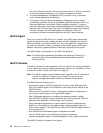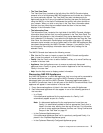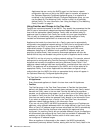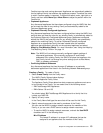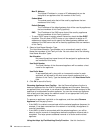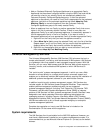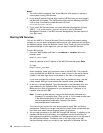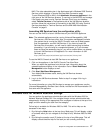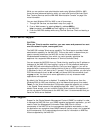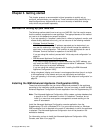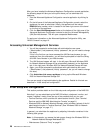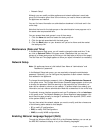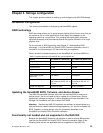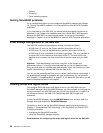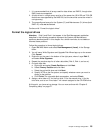
While you can perform most administrative tasks using Windows 2000 for NAS,
there are some advanced tasks for which you must use Terminal Services Client.
See “Terminal Services and the IBM NAS Administration Console” on page 8 for
more information.
You can start Windows 2000 for NAS in one of three ways:
1. Through UM Services, as described in step 3 on page 16.
2. From a Web browser, by entering http://ip_address:8099 or
http://computer_name:8099 and then logging on to the NAS 200.
3. From the NAS 200 desktop while using Terminal Services Client and starting a
browser.
Telnet Server support
CAUTION:
When you Telnet to another machine, your user name and password are sent
over the network in plain, unencrypted, text.
The NAS 200 includes Telnet server capability. The Telnet server provides limited
administrative capability for the NAS 200. This may be useful in cases where you
need to remotely administer the NAS 200, but do not have access to a
Windows-based workstation (from which you could remotely administer the
appliance via a supported Web browser or Terminal Services Client).
You can access the NAS 200 from any Telnet client by specifying the IP address or
hostname of the NAS 200, then logging in using an ID and password (defined on
the NAS 200) with administrative authority. Once you have logged in, you will be
presented with a command-line interface similar to that of a DOS command prompt
in Windows (in fact, it will start at the C:\ prompt). From this interface, you can issue
DOS-like commands (such as dir and cd), and some UNIX-like commands (such
as grep and vi). You can launch some applications, but only character-mode
applications are supported.
By default, the Telnet server is disabled. To enable the Telnet server, from the
Windows 2000 for NAS user interface, go to the Network task group, then select
Telnet. On the Telnet Administration Configuration page that appears, put a check
in the Enable Telnet access to this appliance check box. Later, if you wish to
disable Telnet access, you can uncheck Enable Telnet access to this appliance.If
you do not require Telnet access to the NAS 200, then it is recommended that you
leave the Telnet server disabled.
SNMP support
Support for the Simple Network Management Protocol (SNMP) is enabled. In order
to manage the NAS 200 from your SNMP-capable management application, you will
need to install the Management Information Base (MIB) files for various
components of the NAS 200 on the management application workstation, so that
the application can recognize those SNMP elements (values, alerts, etc.) supported
by the components. Go to www.storage.ibm.com/nas for information on MIB files
that are supported by the NAS 200.
18 NAS 200 User’s Reference



